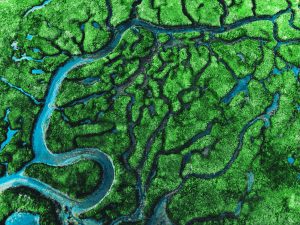
One of the biggest concerns the world faces is water scarcity. Did you know that only 1 percent of Earth’s water is accessible to us? The problem is our dependency on water, not only to drink, but also for things like industrialization, agriculture, and food production. This means that as our global population grows, the demand for recycling water grows exponentially. Occurring at the same time are the impacts of climate change, which lead to longer, more frequent droughts and even scarcer water supplies.
Eventually, that one percent of accessible water will be increasingly harder to find. According to Frost & Sullivan, 50% of all people in the world could be living in areas that face water scarcity by 2025. By 2040, roughly 25% of all children worldwide will be living in areas of extremely high water stress.
Why desalination is an important solution for water scarcity
How can digitization help solve these challenges? Many of our customers use digital solutions to improve efficiency in water and wastewater plants. They also recycle water. One of our clients in Italy, Aqua Novara.Vco S.P.A, used our software suite, EcoStruxure Water Advisor. They cut water loss by 10% and energy use by 15%. The software handles the complete water cycle. It offers digital twin technology for predictive analytics and real-time analysis.
Another customer addressed water scarcity in Izmir, Türkiye’s third largest city, by recycling water for use in agriculture. They took advantage of our flexible automation platform EcoStruxure Automation Expert to help achieve this.
Water management practices are critical, especially in drought or areas with no fresh water. Desalination plays a crucial role here. Research and Markets project the global desalination market to grow over $32 billion by 2027, an 8.8% compound annual growth rate over 2021.
The idea of accessing water from the world’s vast oceans has been around for a long time. But in the past desalination was achieved through the energy-intensive process of thermal desalination, which uses heat to evaporate the water. Now this has been superseded by reverse osmosis, a more efficient, less costly, and more sustainable filtration method that makes desalination a far more viable option for the future.
How do we improve the financial performance and sustainability of desalination?
While the energy consumption of reverse osmosis plants could be optimized to 2.5-3.5 kWh per m³ and desalination rates have reached less than $0.50 per m³, the pressure is still on to boost energy efficiency and drop production costs. It also requires an uninterrupted process and therefore high availability within the control system. On top of the highly advanced control needs, desalination plants also face the same old challenges as other water and wastewater plants – production targets, high production costs exacerbated by process and energy inefficiencies, and lack of visible insights to help workers optimize operations.
To help address these specific needs for desalination we recommend our next-generation control system EcoStruxure Automation Expert. This is the ideal automation platform for these applications because it offers the benefits of traditional automation systems without their traditional limitations. It’s based on the IEC61499 open automation standard and brings many benefits to the water and wastewater sector:
- Hardware agnostic:
It breaks the dependency between application software and the hardware platform it runs on, enabling end-users – for the first time ever – to manage their automation installed base at their own pace. And it makes it easy to integrate with existing automation systems regardless of who made them. - Allows for easier IT/OT convergence:
Industrial operations and desalination plants can easily connect operational systems with IT and business systems – so they can make more effective use of operational data in business decisions and business data in operational decisions. - Facilitates digital continuity across the lifecycle of the plant:
‘Digital Continuity’ is the uninterrupted flow of digital information across a facility’s lifecycle. This requires effective management and integration of various technologies, systems, and processes as a complete, enterprise-wide digital ecosystem. EcoStruxure Automation Expert’s open design makes it easy to integrate into today’s data-driven industrial enterprises and build efficiency at every level for the entire life of their processes.
We’re all part of the global water story and it’s clear we must solve these challenges collectively through climate action and better water management solutions. With regards to digital technology, the high availability features of EcoStruxure Automation Expert mean it perfectly aligns with the needs of modern, reverse osmosis-based desalination technology. Schneider Electric also has a strong presence in desalination, with our solutions found in more than 50% of plants around the world. We’re ideally placed to help people find new sources of water, bringing more water to more places in the world.



